药品说明书、标签的管理规定英文翻译
药品说明书和标签管理(英文版)---24号令

Provisions for Drug Insert Sheets and Labels(SFDA Decree No.24)The Provisions for Drug Insert Sheets and Labels, adopted at the executive meeting of the State Food and Drug Administration on March 10, 2006, is hereby promulgated and shall go into effect as of June 1, 2006.Shao MingliCommissioner of SFDAMarch 15, 2006Provisions for Drug Insert Sheets and LabelsChapter I General ProvisionsArticle 1 The Provisions are enacted with a view to regulating drug insert sheets and labels in accordance with the Drug Administration Law of the People’s Republic of China an d the Regulations for Implementation of the Drug Administration Law of the People’s Republic of China.Article 2 The insert sheets and labels of drugs marketed within the territory of the People’s Republic of China shall meet the requirements of the Provisions.Article 3 Drug insert sheets and labels shall be reviewed and approved by the State Food and Drug Administration.A drug shall be labeled on the basis of its insert sheet. The content of the label shall be within the scope of the insert sheet. Any words and marks with implied therapeutic effects, misleading information on usage, or inappropriate promotion of the product shall not be printed.Article 4 A drug label shall be printed on or affixed to the drug package, and no other written words, audio and/or visual materials or other information are attached to introduce or publicize the product or the enterprise.An insert sheet shall be attached to the smallest package provided by the drug manufacturer for marketing.Article 5 The wording in drug insert sheets and labels shall be scientific, standardized and accurate. The insert sheet of a non-prescription drug shall be written intelligibly and convenient for patients to judge, choose and use the drug on their own.Article 6 In the label or insert sheet, the letters or characters shall be clear and easy to be recognized and the marks shall be clear and distinctive. The label and insert sheet shall have no print faded and shall not be affixed unsteadily. Any addition or modification shall not be made by means of pasting, cutting or altering.Article 7 Drug insert sheets and labels shall be written in standardized Chinese characters published by the National Language Commission. The versions in other languages shall comply with the Chinese version.Article 8 With the aim to protect public health and direct the rational use of drugs, drugmanufacturers may voluntarily apply to add warnings to drug insert sheets or labels. The State Food and Drug Administration may also request drug manufacturers to add warnings to drug insert sheets or labels.Chapter II Drug Insert SheetArticle 9 A drug insert sheet shall include the significant scientific data, conclusions and information concerning drug safety and efficacy in order to direct the safe and rational use of drugs. The specific format, content and writing requirements of drug insert sheet shall be prescribed and issued by the State Food and Drug Administration.Article 10 Disease names, pharmaceutical terms, drug names, the names and results of clinical testing in drug insert sheets shall be expressed in professional terms published or standardized by the State. The units of measurement shall conform to the national standards.Article 11 All the active ingredients or medicinal ingredients of traditional Chinese medicines in a prescription shall be listed in the insert sheet. For injections and non-prescription drugs, all excipients shall be listed as well.The ingredients or excipients included in a prescription, which may cause severe adverse reaction, shall be specified.Article 12 A drug manufacturer shall trace the safety and efficacy of its marketed drugs. For any modification to the insert sheet, an application shall be submitted timely.The State Food and Drug Administration may also require a drug manufacturer to make modification to the insert sheet on the basis of the results of adverse drug reaction monitoring and drug re-evaluation.Article 13 After the modification to the insert sheet is approved, the drug manufacturer shall inform relevant drug distributors, drug users and other departments of the modified content immediately, and use the modified insert sheet and label timely as required.Article 14 The insert sheet shall provide full information on adverse drug reaction and indicate the adverse reactions in detail. A drug manufacturer, who fails to timely modify the insert sheet on the basis of the safety and efficacy data of the marketed drug or to fully explain the adverse reaction in the insert sheet, shall be liable for all the consequences arising therefrom.Article 15 The approval date and the modification date shall be distinctively shown in the insert sheet.Chapter III Drug LabelsArticle 16 Drug labels refer to the information printed or pasted on drug packaging, including inner labels and outer labels. Inner labels refer to those that appear on immediate packaging; outer labels are those on the other packaging outside of inner labels.Article 17 The inner label shall bear such drug information as the adopted name in China, indications or functions, strength, dose and usage, production date, batch number, expiry date and manufacturer. If there is no enough space in the package to include all the information mentionedabove, the adopted name in China, strength, batch number and expiry date shall be indicated at least.Article 18 The outer label of a drug shall indicate such information as the adopted name in China, ingredients, description, indications or functions, strength, dose and usage, adverse reactions, contraindications, precautions, storage, production date, batch number, expiry date, approval number and manufacturer. Where indications or functions, dose and usage, adverse reactions, contraindications and precautions c annot be fully noted, main information plus a “See drug insert sheet for details.” notice shall be indicated.Article 19 The label on the package for transportation and storage shall bear at least the adopted name in China, strength, storage, production date, batch number, expiry date, approval number and manufacturer. Other information such as packaging quantity, precautions for transportation or other marks may be included when necessary.Article 20 The label for drug substance shall include the adopted name in China, storage, production date, batch number, expiry date, applied specifications, approval number and manufacturer. Other necessary information such as packaging quantity and precautions for transportation shall also be indicated.Article 21 Where one drug produced by a manufacturer has the same drug strength and packaging specification, the content, format and color of its labels must be the same. Where one drug produced by a manufacturer has different drug strengths or packaging specifications, its labels shall be clearly distinguished from one another, or its specifications shall be notably marked in the corresponding specification items.Where a drug produced by a manufacturer is administrated as prescription drug and non-prescription drug respectively, their packaging colors shall be distinctly different.Article 22 For drugs with special requirements on storage, its requirements shall be marked in the notable place of the label.Article 23 The expiry date in the drug label shall appear in the order of year, month and day, with year shown in four digits, month and day in two digits. Its specific format shall be “V alid till XXXX year XX month” or “Valid till XXXX year XX month XX day”. It may be presented with numbers and othe r symbols as “Valid till XXXX.XX.” or “Valid till XXXX/XX/XX”.For the preventive biological product, the expiry date shall be labeled according to the registration specifications approved by the State Food and Drug Administration. The expiry date of the biological product for therapeutic use shall be counted from the filling date. For other drugs, the expiry date shall be counted from the production date.Where the expiry date is labeled to the day, it shall be marked as one day earlier than the actual expiry date; where the expiry date is labeled to the month, it shall be marked as one month earlier than the actual expiry month.Chapter IV Use of Drug Name and Registered TrademarkArticle 24 The drug name in insert sheets and labels shall conform to the nomenclature principles on the adopted name in China and trade name of drug announced by the State Food and Drug Administration, and shall be consistent with those appeared in the approval documents of the drug.Article 25 The adopted name in China shall be conspicuous and prominent, and its typeface, size and color shall be consistent, and meet the following requirements:(1) For horizontal labels, the adopted name in China shall appear in a prominent position within the area of the upper one-third of the label; for vertical labels, it shall appear in a prominent position within the area of the right one-third of the label;(2) No such illegible typefaces as cursive characters and seal characters shall be used, and no such format as italics, margining and shading shall be used to modify the typefaces.(3) The font color of the adopted name in China shall be black or white, in sharp contrast to the light-colored or dark-colored background respectively.(4) Writing in separate lines shall be avoided unless limited by the packaging size.Article 26 The trade name of a drug shall not be placed in the same line with the adopted name in China; its typeface and color shall be no more conspicuous than that of the adopted name in China, and its font area per character shall be no bigger than half of that of the adopted name in China.Article 27 Unregistered trademarks and other drug names unapproved by the State Food and Drug Administration shall not be used in the drug insert sheets and labels.Where a registered trademark is used in a drug label, it shall be printed in a corner of the label. Where a registered trademark contains characters, the font area per character shall be no bigger than a quarter of that of the adopted name in China.Chapter V Other ProvisionsArticle 28 For narcotic drugs, psychotropic substances, medicinal toxic drugs, radioactive pharmaceuticals, drugs for topical use, non-prescription drugs and other drugs having special marks specified by the State, their special marks shall be printed in the drug insert sheets and labels.Where there are special provisions issued by the State for drug insert sheets and labels, they shall prevail.Article 29 The labeling provisions for Chinese crude drugs and prepared slices of Chinese crude drugs shall be formulated separately by the State Food and Drug Administration.Article 30 Where drug insert sheets and labels are not in compliance with the Provisions, a punishment shall be imposed in accordance with the relevant provisions of the Drug Administration Law of the People’s Republic of China.Chapter VI Supplementary ProvisionsArticle 31 These Provisions shall come into force as of June 1, 2006. the Provisions for Drug Packaging, Labels and Insert Sheets (Provisional) issued by State Food and Drug Administration on October 15, 2005 shall be annulled therefrom.。
药品说明书翻译
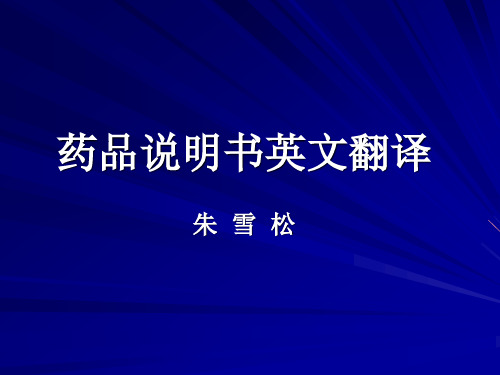
药理作用
药理作用(Pharmacological Actions)。其内 容主要包括药理作用、临床药理(Clinical Parmacology)、体外试验(in vitro experiments)、药物代谢(Metabolism)、药 效(Potency)及毒性(Toxicity)等。这一项常 用的标题是: Pharmacological Action 药理作用 Pharmacological Properties 药理性质 Pharmacology 药理学 Clinical Pharmacology 临床药理
Description(性状)
在药品说明书及药典中一般都译为“性状”,其 内容主要是介绍外观、理化性质、组成成分、结 构、特征等。这一项最常用的标题是Description, 此外还可能有其他的表示法,如: Chemical Structure 化学结构 Composition 成分 Physical and Chemical Properties 理化性质 特点:这一项中的英语词汇除一部分化学专业 词汇外,多为常用词,借助英汉化学化工词典及 英汉词典即可通读。
相关法律法规
中华人民共和国药品管理法 药品包装、标签和说明书管理规定 进口药品管理办法 第六章 药品名称、包装、标签和说明书 第三十四条 进口药品必须使用中文药品名称,必须符合 中国药品命名原则的规定。 第三十五条 进口药品的包装和标签,必须用中文注明药 品名称、主要成分以及注册证号,进口药品必须使用中文 说明书。 第三十六条 进口药品的包装、标签和说明书,必须符合 中国《药品包装、标签和说明书管理规定》,并经国家药 品监督管理局批准后使用。一经有: Actions 作用 Actions and Properties 作用与性质 Clinical Effect (Use) 临床效果(用途) Mechanism of Action 作用机理 Mode of Action 作用方式 如果药品的一种抗生素,可能出现: Biological Action 生物活性 Microbiology 微生物学
药品说明书英文翻译
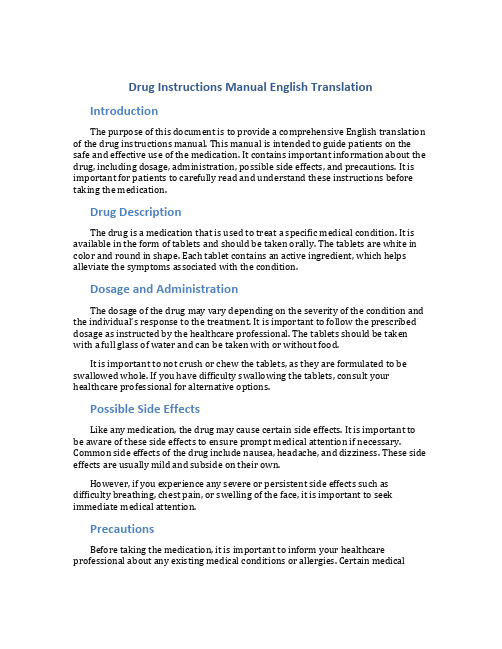
Drug Instructions Manual English Translation IntroductionThe purpose of this document is to provide a comprehensive English translation of the drug instructions manual. This manual is intended to guide patients on the safe and effective use of the medication. It contains important information about the drug, including dosage, administration, possible side effects, and precautions. It is important for patients to carefully read and understand these instructions before taking the medication.Drug DescriptionThe drug is a medication that is used to treat a specific medical condition. It is available in the form of tablets and should be taken orally. The tablets are white in color and round in shape. Each tablet contains an active ingredient, which helps alleviate the symptoms associated with the condition.Dosage and AdministrationThe dosage of the drug may vary depending on the severity of the condition and the individual’s response to the treatment. It is important to follow the prescribed dosage as instructed by the healthcare professional. The tablets should be taken with a full glass of water and can be taken with or without food.It is important to not crush or chew the tablets, as they are formulated to be swallowed whole. If you have difficulty swallowing the tablets, consult your healthcare professional for alternative options.Possible Side EffectsLike any medication, the drug may cause certain side effects. It is important to be aware of these side effects to ensure prompt medical attention if necessary. Common side effects of the drug include nausea, headache, and dizziness. These side effects are usually mild and subside on their own.However, if you experience any severe or persistent side effects such as difficulty breathing, chest pain, or swelling of the face, it is important to seek immediate medical attention.PrecautionsBefore taking the medication, it is important to inform your healthcare professional about any existing medical conditions or allergies. Certain medicalconditions or allergies may interact with the drug and affect its effectiveness or cause adverse reactions.It is also important to inform your healthcare professional about any other medications or supplements you are currently taking. Some medications may interact with the drug and cause potential harm.StorageThe drug should be stored in a cool and dry place, away from direct sunlight and moisture. It should be kept out of reach of children and pets. Do not use the medication after the expiration date printed on the packaging.ConclusionThis is a summary of the drug instructions manual in English. It provides important information about the medication, including dosage, administration, possible side effects, and precautions. It is essential for patients to carefully read and understand these instructions before taking the medication to ensure the safe and effective use of the drug. If you have any questions or concerns, consult your healthcare professional for further guidance.。
制药专业英语-药品说明书

本项中出现频率最高的是疾病名称以及微生物 (尤其是致病菌)的名称,如:
angina pectoris 心绞痛
cancer癌 diabetes(mellitus)糖尿病 hypertension 高血压 gram-positive microorganisms (bacteria)革兰氏阳性菌
virus 病毒
第三节 药理作用 (Pharmacological Actions) 主要内容
药理作用 (Pharmacological Action) 临床药理 (Clinical Parmacology) 体外试验 (in vitro experiments) 药物代谢 (Metabolism) 药效 (Potency) 毒性 (Toxicity)
常用词及短语举例
名词
ability 能力 activity 活性 distribution 分布 excretion 排泄
action 作用
clearance 廓清率
effect on 对…的作用
in vitro 体外
function 功能,作用 kidney 肾
half life 半衰期
mechanism 机理 infection 感染
常见句型
本项是说明书的重点,从句子结构来分析,大致有以下几种类型。
1. 不完全句结构。仅列出疾病或微生物的名称。
例如:
例1 Angina pectoris, hypertension. 心绞痛,高血压。
2. 由For(或In等)引出的短语,例如:
例2 In the treatment of all forms of pulmonary tuberculosis in association with other antitubercular drugs. 与其他抗结核药配伍,治疗各种类型肺结核。 例3 For prevention of the advance of cataract. 用于预防白内障进展。
药品英文说明书翻译

药品英文说明书翻译篇一:英语药品说明书的翻译英语药品说明书的翻译英语药品说明书由以下12项内容组成,大多数英语药品说明书结构基本相同。
1. Pakage Insert (Insert)说明书2. Drug Name (Medicine) 药品名称3. Description 性状4. Action 作用5. Indication适应症6. Contraindications 禁忌症7. Precaution注意事项 8. Side Effects副作用9. Dosage and Administration 剂量和用法10. Dacking 包装11.Expiry 失效期 12. Manufactring Date (Manu.date)出厂日期13.Reference 参考文献药品名称一、英语药品说明书一般用商品名,由生产厂家向该国政府有关部门申请注册正式名称,受该国政府法律保护,在药品名称的右上角有个○R的符号,意思是已经申请注册的法定名称,不可随意改变名称。
○R=Recive在药品之后有时Issued to(for) the Medical profession only短语,意:仅供医界参考。
R例:Mobic ○Issued to(for) the medical prfession.二、译法:分四种译法1. 音译:按英语读音用相应的汉字译出例: Mobic莫比可 Rifampicin利福平2. 意译:按药品名称各组成部份的英语意义译成汉语例: Streptomycine是由Strepto和mycine组成,其中Strepto(链球状),mycine(霉素),则按英语意思,译成:链霉素。
因此必须掌握大量前、后缀,才以准确翻译,此种译法多数是抗生素类药物。
Nitroglycerine 由Nitro(硝基)+glycer(本文来自: 小草范文网:药品英文说明书翻译)in(甘油)组成,则意为硝酸甘油 Aminophylline由Amino+phylline译:氨茶碱3. 音意并译:按英语药名组成,前面部份按音译,后面部份按意译。
专业英语药品说明书

药品的适用范围 Indications
说明药品对哪些病菌、疾病有效或无效,是说明书的重点。 适应症 Indication (适应症) Uses(用途) Major indication, principal indication(主要适应症)
用法 Adminstration, direction (用法) Dosage, posology:剂量 Usage and dosage /Administration and dosage:用法与剂量 常用表达 Daily, per day, a day, every day; Every 8 hours, 8 hours apart, eight-hourly, at intervals of 8 hours; Once daily, twice daily, three times daily, every other day/every second day 50 mg per kilo of body weight daily
安替司丁 治疗过敏性病症的抗组胺剂 性质 安替司丁可减弱或抑制组胺作用,组胺在激发过敏性病症中起主要作用。本品的适应症正是根据这种实验证明的抗组胺作用来确定的。 适应症 荨麻疹、食物过敏、枯草热、血管舒缩性鼻炎;由于皮肤病症引起的搔痒包括湿疹、搔痒病和血清病。
Administration and dosage Tableis adults; 1tablet 3-4 time daily. Small children; ½ tablet 2-3 time daily. The tablets should be taken during meals and swallowed whole with a little fluid. Ampoules 1 ampoule, given by intramuscular or slow intravenous injection, 2-3 times daily. For children the doses should be correspondingly reduced服法与剂量 片剂 成人:每次1片,一日3-4次。 小儿:每次1/2片,一日1次。 本片剂应在餐间服用,以少许水整个吞服。 针剂 每次1瓶,一日2-3次,肌肉或缓慢静注射。儿童剂量应相应减少。
《医疗器械说明书、标签和包装标识管理规定》(局令第10号)_EN

Provisions for Instructions, Labels and Packages for Medical Devices(SFDA Order No. 10)_____________________________________________________________________Order of the State Food and Drug AdministrationNo. 10The “Provisions for Instructions, Labels and Packages for Medical Devices” passed by the State Food and Drug Administration at the administrative affairs meeting of June 18th of 2004 are hereby promulgated and shall go into effect as of the promulgation date.Xiaoyu Zheng, Director - GeneralJuly 8, 2004 Provisions for Instructions, Labels and Packages for Medical DevicesArticle 1 The present provisions are stipulated in accordance with the Regulations for the Supervision and Administration of Medical Devices to standardize the instructions,labels, and packages for medical devices and to ensure the safe use of medical devices.Article 2 All of the medical devices that are sold and used in the territory of the People’s Republic of China shall have instructions, labels, and packages in accordance withthe present provisions. For products that are simple and easy to use, one or two of thethree items, namely instructions, label or package, can be omitted according to theregulations of State Food and Drug Administration; the regulations are to be followedaccordingly.Article 3 Users of a medical device shall use the medical device in accordance with the instructions for the medical device.Article 4 The term “instructions for a medical device” refers to the technical document that is prepared by the manufacturer and provided to the consumer together with theproduct, covering the basic information concerning the safety and efficacy of the saidproduct, which is used as the directions for the correct installation, adjustment,operation, use, maintenance and repair of the device.The term “label of a medical device” refers to the written descriptions, figures, andsymbols that are attached to the medical device or the package and used foridentifying the special features of the product.The te rm “package of a medical device” refers to the written descriptions, figures,and symbols on the package that reflect the main technical features of the medicaldevice.Article 5 The contents of the instructions, label, and package for a medical device should be truthful, complete, accurate, scientific and consistent with the special features of theproduct.The contents of the label and package of a medical device should be consistent withthose of the instructions.Article 6 The contents of the instructions, label, and package for a medical device must be in Chinese; other languages can be added. The use of the Chinese language should beconsistent with national language norms.The writing, symbols, figures, tables, numbers, photographs, graphs, etc. of theinstructions, label, and package for a medical device should be accurate, clear, andstandard.Article 7 The instructions for a medical device should comply with national standards or industry standards and should normally include the following contents:(1)The product name, model number, and specifications;(2)Name of the manufacturer, registered address, manufacturing address, meansof contact, and the department of after-sale service;(3)Licence number of the “Medical Device Manufacturer Licen c e” (except forcategory one medical devices) and certificate number of the Medical DeviceCertificate of Registration;(4)The product’s standard serial number;(5)The product’s function, main structure, and scope of application;(6)Contraindications, precautions and other content requiring warnings orreminders;(7)Explanations of the figures, symbols, abbreviations, etc. used in the label of themedical device;(8)Instructions or diagrams for installation and use;(9)Method of maintenance and repair of the product, special storage conditionsand methods;(10)For products with an expiry date, the shelf life (period of stability) should beindicated;(11)Other contents specified in the product standards that should be indicated in theinstructions.Article 8 The contents of the label and package of a medical device should normally include the following:(1)The product name, model number and specifications;(2)Name of the manufacturer, registered address, manufacturing address and meansof contact;(3)Certificate number of the Medical Device Certificate of Registration;(4)The product’s standard serial number;(5)Date of manufacture of the product or the batch (order) number;(6)Conditions for power connection and input power;(7)For products with an expiry date, the shelf life (period of stability) should beindicated;(8)The figures, symbols and other relevant content that should be indicated on thebasis of the product’s special features.Article 9 The instructions, label, and package shall not have the following types of content:(1)Claims or guarantees of efficacy such as “best efficacy”, “guaranteed cure”,“assured cure”, “radical cure”, “effective immediately”, “absolutely no toxicityor side effects”, etc.;(2)D efinitive language and expressions such as “the highest technology”, “the mostscientific”, “the most advanced”, “the best” etc.;(3)Description of the cure rate or efficacy rate;(4)Comparison of the efficacy and safety with those of other company’s products;(5)P romises such as “insured by insurance companies”, “if ineffective, a refund willbe granted”, etc.;(6)Recommendations or endorsements by the name or image of any organization orindividual;(7)Expressions that make people feel that they have already suffered from a certaindisease or lead people to believe that they will suffer from a certain disease ortheir condition will be aggravated if they do not use the said medical device;(8)Other content that is prohibited by laws and regulations.Article 10 The product name of a medical device should comply with the corresponding national standards and regulations.Article 11 The product name of a medical device should be clearly indicated in a prominent position in the instructions and on the label and package, and it should be consistentwith the product name on the Medical Device Certificate of Registration.Article 12 If the medical device has a commercial name, the commercial name can be simultaneously indicated in the instructions, label, and package, but it should beconsistent with the commercial name indicated on the Medical Device Certificate ofRegistration. When the product name and the commercial name are both indicated,they should be mentioned on separate lines and may not be connected, and thecharacter size of the commercial name of the medical device may not be larger thantwice that of the product name.Definitive language that exaggerates or asserts the efficacy of the product may not beused in the commercial name of the medical device and the terms may not violateother laws and regulations.Article 13 The content of relevant precautions, warnings, and reminders in the instructions for medical devices mainly include:(1)Possible side effects of using the product;(2)Protective measures and appropriate emergency and corrective measures to betaken by the operator and user if an accident occurs during the proper use of theproduct,(3)Single-use (disposable) products should be marked with a written statement orsymbol for “Single Use”;(4)Sterilization methods should be indicated for sterilized products and statementsor marks for “S terilized” should be a dded, and methods of dealing with damagedsterile packaging should be indicated;(5)The sterilization or disinfection method shall be indicated if the product needs tobe sterilized or disinfected before it is used;(6)If the product needs to be installed along with other products or operated inconjunction with other products, the requirements for such joint use should beindicated;(7)Dangers that may arise from mutual interference with other products in thecourse of use;(8)If treatment is needed after the product is used, the corresponding treatmentmethod should be specified;(9)According to the special features of the product, other warnings to the operatorand user as appropriate.Article 14 The contents related to installation in the instructions of a medical device should ensure that the operators and users correctly install and use the product and shouldinclude:(1)Installation instructions for the product along with technical diagrams and circuitdiagrams;(2)The environmental conditions required for correct installation of the product andthe technical information that identifies whether the installation is correct;(3)Other special installation requirements.Article 15 The instructions for a medical device shall be submitted to the Department of (Food) Drug Supervision and Administration for review when the manufacturer applies forthe registration of the medical device in accordance with the “Provisions of MedicalDevice Registration and Administration” and the content of the submitted instructionsfor the medical device shall be consistent with the other materials accompanying theapplication for registration.Article 16 The manufacturer shall be responsible for the truthfulness and completeness of the instructions for a medical device.Article 17 The content of the instructions for a medical device that has been registered and reviewed by the Department of (Food) Drug Supervision and Administration shall notbe altered without authorization.Article 18 If the altered contents of the instructions relate to conditions that are stipulated in the “Provisions of Medical Device Registration and Administration” and require re-registration of the medical device, such alterations may not be managed simply bychanging the instructions.Article 19 If the manufacturer intends to alter the contents of the instructions for a medical device that have been registered and reviewed and the changes do not involvetechnical changes to the product, the manufacturer shall submit the relevantdocuments to the original approving department with which the medical device isregistered and notify the department in writing. Relevant documents include at leastthe following:(1) A copy of the instructions that have been registered, reviewed and filed;(2)The altered draft of the instructions;(3) A description of the changes in the instructions (including a comparative table ofchanges);(4)The revised document of the standard of the registered product (limited to thechange in content of the instructions that relate to the revision of the text of thestandard);(5) A statement of the authenticity of the submitted materials.If the original approving registration department does not issue a written notice ofobjection within 20 working days from the date that the department receives thewritten notice of changing the instructions for the medical device from themanufacturer, the changes in the instructions will be effective and filed by theoriginal approving department; if the original approving registration departmentissues a written notice within 20 working days, the manufacturers should take actionin accordance with the requirements in the notification.Article 20 Violation of the present provisions by one of the following actions will result in the issue of a warning by the Department of (Food) Drug Supervision andAdministration, at county level or above, and the manufacturer will be ordered to takecorrective measures within a specified period; the action will be recorded in theManufacturer Supervision and Administration File:(1)Altering the contents of already registered and filed instructions withoutauthorization;(2)The label and package of the commercial product not being in accordance withthe registered and filed product instructions, or otherwise violating therequirements of the present provisions;(3)The product name or commercial name of the medical device being in violationof the present provisions;(4)The marketed product, except for easy-to-use products and other products thatare regulated separately by the State Food and Drug Administration, not havinginstructions, a label or a package based on the present provisions.Article 21 If the manufacturer of a medical device independently increases the scope of the product application or indication in the instructions for a medical device withoutauthorization, the said manufacturer will be punished by the Department of (Food)Drug Supervision and Management, at county level and above, in accordance withArticle 35 of the “Regulation on Supervision and Administration of MedicalDevices” by not being granted a M edical Device Certificate of Registration.Article 22 The State Drug Administration is responsible for the interpretation of the present provisions.Article 23The present provisions shall go into effect as of the promulgation date. The “Provisions fo r Instructions for Medical Devices” issued by the State Drug Supervision andAdministration on January 4, 2002 will be annulled at the same time.。
药品英文说明书药品英文说明书
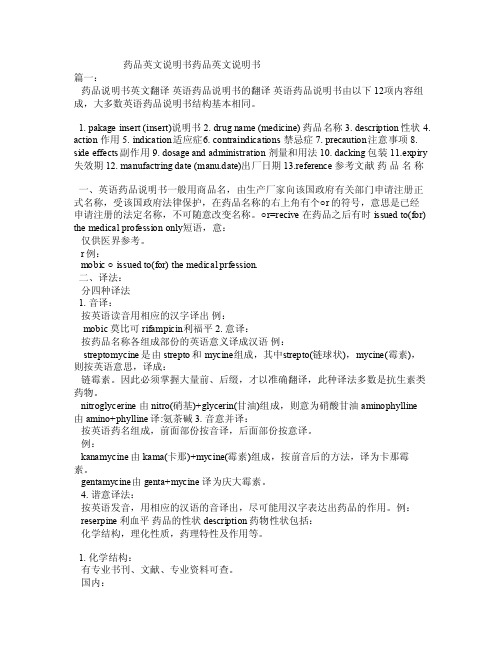
药品英文说明书药品英文说明书篇一:药品说明书英文翻译英语药品说明书的翻译英语药品说明书由以下12项内容组成,大多数英语药品说明书结构基本相同。
1. pa kageinser t (in sert)说明书2. drug name (med icine) 药品名称 3.descr iptio n 性状4. ac tion作用 5. indi catio n适应症6. con train dicat ions禁忌症7. pre cauti on注意事项 8.sideeffec ts副作用 9. d osage andadmin istra tion剂量和用法 10.dacki ng 包装 11.e xpiry 失效期12. m anufa ctrin g dat e (ma nu.da te)出厂日期 13.refe rence参考文献药品名称一、英语药品说明书一般用商品名,由生产厂家向该国政府有关部门申请注册正式名称,受该国政府法律保护,在药品名称的右上角有个○r的符号,意思是已经申请注册的法定名称,不可随意改变名称。
○r=re cive在药品之后有时iss ued t o(for) the medi cal p rofes siononly短语,意:仅供医界参考。
r例: mob ic ○issue d to(for)the m edica l prf essio n.二、译法:分四种译法1. 音译:按英语读音用相应的汉字译出例:mobic莫比可r ifamp icin利福平 2.意译:按药品名称各组成部份的英语意义译成汉语例:strep tomyc ine是由strep to和my cine组成,其中s trept o(链球状),myc ine(霉素),则按英语意思,译成:链霉素。
药品说明书翻译指南

药品说明书翻译指南药品说明书翻译指南1:药品名称Drug Name“药品说明书”的英文表达方式有Instructions,Directions,Description。
现在多用Package Insert,或简称Insert,也有用Leeflet或Data Sheets。
Insert原意为“插入物,插页”。
药品说明书即为附在每种药品包装盒中的一份用药说明。
经过注册的进口药品一般是国家承认的有效药物,其说明书是指导医生与患者合理用药的重要依据,具有一定的法律效力。
本系列具体讲述了进口药品说明书的语言特点及翻译方法。
虽然药品和食品不同,但通用的时候还是用得着的。
“药品说明书”的英文表达方式有Instructions,Directions,Description。
现在多用Package Insert,或简称Insert,也有用Leeflet或Data Sheets。
Insert原意为“插入物,插页”。
药品说明书即为附在每种药品包装盒中的一份用药说明。
经过注册的进口药品一般是国家承认的有效药物,其说明书是指导医生与患者合理用药的重要依据,具有一定的法律效力。
进口药的英文说明书随药品来源的不同,有以英语为母语的国家,也有以英语为外语的国家。
说明书繁简难易不同。
短者仅百余词,长者可达上万词。
较简单的悦明书仅介绍成分、适应症、禁忌症、用法与用量等内容;较详尽的说明书中除上述内容外还包括:药品性状、药理作用、临床药理、临床前动物试验、临床经验、药代动力学、庄意事项、不良反应或副作用、用药过量、药物的相互作用、警告、有效期、包装、贮存条件、患者须知及参考文献等诸多项目。
为了顺利阅读和正确翻译进口药英文说明书,读者除应具备较好的英语基础,掌握一定的专业知识(如医学、化学、药剂学、药理学、药物代谢动力学等)外,还应熟悉英文药品说明书的结构及语言待点等。
大多数英文说明书都包括以下内容;①药品名称(Drug NameS),②性状(Description),③药理作用(Pharmacological Actions),④适应症(Indications),⑤禁忌证(Contraindications),⑥用量与用法(DOsage and Administration).⑦不良反应(Adverse Reactions)。
药品说明书翻译指南
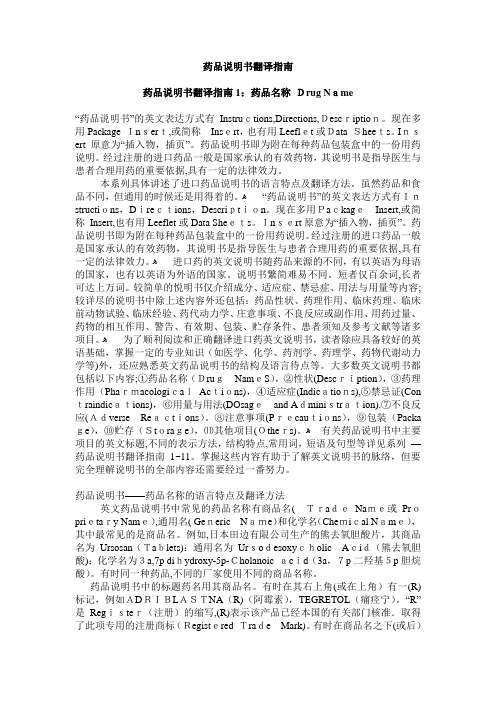
药品说明书翻译指南药品说明书翻译指南1:药品名称Drug Name“药品说明书”的英文表达方式有Instructions,Directions,Description。
现在多用Package Insert,或简称Insert,也有用Leeflet或Data Sheets。
Insert原意为“插入物,插页”。
药品说明书即为附在每种药品包装盒中的一份用药说明。
经过注册的进口药品一般是国家承认的有效药物,其说明书是指导医生与患者合理用药的重要依据,具有一定的法律效力。
本系列具体讲述了进口药品说明书的语言特点及翻译方法。
虽然药品和食品不同,但通用的时候还是用得着的。
ﻫ“药品说明书”的英文表达方式有Instructions,Directions,Description。
现在多用PackageInsert,或简称Insert,也有用Leeflet或Data Sheets。
Insert原意为“插入物,插页”。
药品说明书即为附在每种药品包装盒中的一份用药说明。
经过注册的进口药品一般是国家承认的有效药物,其说明书是指导医生与患者合理用药的重要依据,具有一定的法律效力。
ﻫ进口药的英文说明书随药品来源的不同,有以英语为母语的国家,也有以英语为外语的国家。
说明书繁简难易不同。
短者仅百余词,长者可达上万词。
较简单的悦明书仅介绍成分、适应症、禁忌症、用法与用量等内容;较详尽的说明书中除上述内容外还包括:药品性状、药理作用、临床药理、临床前动物试验、临床经验、药代动力学、庄意事项、不良反应或副作用、用药过量、药物的相互作用、警告、有效期、包装、贮存条件、患者须知及参考文献等诸多项目。
ﻫ为了顺利阅读和正确翻译进口药英文说明书,读者除应具备较好的英语基础,掌握一定的专业知识(如医学、化学、药剂学、药理学、药物代谢动力学等)外,还应熟悉英文药品说明书的结构及语言待点等。
大多数英文说明书都包括以下内容;①药品名称(DrugNameS),②性状(Description),③药理作用(PharmacologicalActions),④适应症(Indications),⑤禁忌证(Con traindications),⑥用量与用法(DOsageand Administration).⑦不良反应(Adverse Reactions)。
药品英文说明书翻译

药品英文说明书翻译篇一:英语药品说明书的翻译英语药品说明书的翻译英语药品说明书由以下12项内容组成,大多数英语药品说明书结构基本相同。
1. Pakage Insert (Insert)说明书2. Drug Name (Medicine) 药品名称3. Description 性状4. Action 作用5. Indication适应症6. Contraindications 禁忌症7. Precaution注意事项 8. Side Effects副作用9. Dosage and Administration 剂量和用法10. Dacking 包装11.Expiry 失效期 12. Manufactring Date (Manu.date)出厂日期13.Reference 参考文献药品名称一、英语药品说明书一般用商品名,由生产厂家向该国政府有关部门申请注册正式名称,受该国政府法律保护,在药品名称的右上角有个○R的符号,意思是已经申请注册的法定名称,不可随意改变名称。
○R=Recive在药品之后有时Issued to(for) the Medical profession only短语,意:仅供医界参考。
R例:Mobic ○Issued to(for) the medical prfession.二、译法:分四种译法1. 音译:按英语读音用相应的汉字译出例: Mobic莫比可 Rifampicin利福平2. 意译:按药品名称各组成部份的英语意义译成汉语例: Streptomycine是由Strepto和mycine组成,其中Strepto(链球状),mycine(霉素),则按英语意思,译成:链霉素。
因此必须掌握大量前、后缀,才以准确翻译,此种译法多数是抗生素类药物。
Nitroglycerine 由Nitro(硝基)+glycer(本文来自: 小草范文网:药品英文说明书翻译)in(甘油)组成,则意为硝酸甘油 Aminophylline由Amino+phylline译:氨茶碱3. 音意并译:按英语药名组成,前面部份按音译,后面部份按意译。
英语药品说明书的翻译

英语药品说明书的翻译英语药品说明书由以下12项内容组成,大多数英语药品说明书结构基本相同。
1. Pakage Insert (Insert) 说明书2. Drug Name (Medicine) 药品名称3. Description 性状4. Action 作用5. Indication 适应症6. Contraindications 禁忌症7. Precaution 注意事项8. Side Effects 副作用9. Dosage and Administration 剂量和用法10. Dacking 包装11.Expiry 失效期12. Manufactring Date (Manu.date)出厂日期13.Reference 参考文献药品名称一、英语药品说明书一般用商品名,由生产厂家向该国政府有关部门申请注册正式名称,受该国政府法律保护,在药品名称的右上角有个○R的符号,意思是已经申请注册的法定名称,不可随意改变名称。
○R=Recive在药品之后有时Issued to(for) the Medical profession only短语,意:仅供医界参考。
例:Mobic ○R Issued to(for) the medical prfession.二、译法:分四种译法1. 音译:按英语读音用相应的汉字译出例:Mobic 莫比可Rifampicin 利福平2. 意译:按药品名称各组成部份的英语意义译成汉语例:Streptomycine 是由Strepto和mycine组成,其中Strepto(链球状),mycine(霉素),则按英语意思,译成:链霉素。
因此必须掌握大量前、后缀,才以准确翻译,此种译法多数是抗生素类药物。
Nitroglycerine 由Nitro(硝基)+glycerin(甘油)组成,则意为硝酸甘油Aminophylline由Amino+phylline 译:氨茶碱3. 音意并译:按英语药名组成,前面部份按音译,后面部份按意译。
药品说明书翻译(1)

• brown 棕色 • brownish 浅棕色的
• transparent 透明的 • opaque 不透明的 • off-white 类白色 或 黄白色的 • stable 稳定的
• molecular formular • molecular weight • chemical structure
• c. 音意合译 Medemycin 麦迪霉素(-mycin 霉素) • d. 谐音 Legalon利肝隆,Webilin胃必灵 • e. 按药理作用或药物成分翻译
药品说明书翻译(1)
二.药品性状(Description)
药品性状:包括药品的外观、理化性质、成分、结 构、特征等。 除了用Description外,还常用Property/Properties; Physical and chemical properties; Characteristics (性状); 有些说明书介绍很简单,仅给出化学结构或成分, 标题为: • Chemical structure(化学结构); • Composition (成分) • Active ingredients (有效成分) 等
药品说明书翻译(1)
• 例1.Folic acid is a yellowish to orange, crystalline powder; odourless or almost odourless.
• 叶酸是淡黄色至橙色结晶粉沫,无臭或几乎无臭。 •
例2.Intralipos 10% is a white opaque fat emulsion for intravenous injection, containing 10 W/V % of purified soybean oil. •
专业英语药品说明书
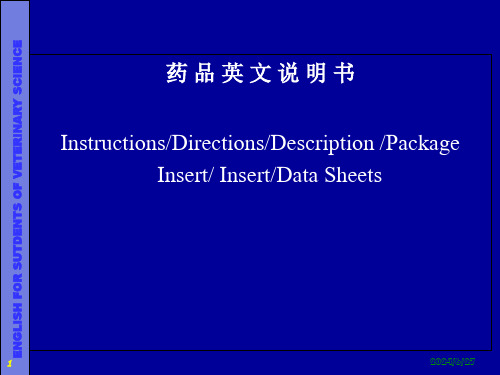
Medemycin(麦迪霉素)
➢ 谐音译意:以音译为原则,选用谐音的汉字,既表音,又表意,音意结 合。
Reserpine(利血平); Webilin(胃必灵) ; Legalon(利肝隆 )
3
2024/6/27
ENGLISH FOR SUTDENTS OF VETERINARY SCIENCE
药品的化学名称反映出该药品的化学结构组成成分
动
物 ➢ 2 g per day in 2 equally divided doses
医
学 • 每日2克,分为二等份
院
➢ 100 units twice daily
• 每日2次,每次100 单位
➢ 100 to 200 units per kg body weight in 6 divided doses
南
农 业
毒性
大
学 动
➢ Toxicity
物 医
耐受性
学
院 ➢ Tolerance
禁忌症
➢ contraindication
12
2024/6/27
ENGLISH FOR SUTDENTS OF VETERINARY SCIENCE
包 装 Package
剂型
➢ Tablets(糖衣片,sugar-coated tablets), dragees(糖衣丸),
Administration and dosage(用法和剂量)
Tables
湖 南
adults; 1tablet 3-4 time daily.
农 业
Small children; ½ tablet 2-3 time daily.
大 学
The tablets should be taken during meals and
药品说明书、标签管理规定的英文翻译

Administrative Regulation for Insert and packaging Labels of drug(SFDA Order No.24)State Food and Drug Administration OrderNo.24“Administrative Regulation for Insert and packaging Labels of Drug” had been evaluated & agreed by the management meeting of SFDA by Mar.10, 2006, and publish here, the same to be implemented since June 1st, 2006.SFDA Director: Shao Ming LiMar. 15, 2006 Administrative Regulation for the Insert and Packaging Labels of DrugSection I General rulesNo.1 For standardizing the administration for the insert and packaging labels of drug on the basis of “Drug Administration law of the P. R. of China” and “Regulations for Implementation of the Drug Administration Law of the P. R. of China”.No.2 Relevant inserts and packaging labels for all the drugs which are sold in china to be in line with the requirements from present regulation.No.3 The Inserts and packaging labels of drugs should be approved by SFDA.The packaging labels of drugs to be drafted as per the insert, their text should not exceed the range of insert, and should not contain the character and mark which suggests the efficacy, mislead uses and unsuitable publicity the product.No.4 The label should be printed or stickled on the package for drug as per relevant regulations, and can’t carry any other character, audiovisual, or material for introduction or publication propaganda for product and / or manufacturer.The smallest pack sold in market from the pharmaceutical manufacturer should contain insert.No.5 The text expression for drug’s insert and labels should be scientific, standard and accurate.The text expression for the insert for OTC drug should be easy for understanding for the patients whom could be able to self judges, selects and uses.No.6 The text of drug’s insert and labels should be clear and easy to be differentiated, the mark should be clear and striking, the appearance with dropping words or unstick etc. should not appear, and can't be modified or supplemented by sticking, cutting or altering.No.7 The standard Ch. Character published by State Spoken and Written Language Committee should be used for the insert and labels of drug, the Ch. Character expression will be the criterion when has additional other language for reference.No.8 For the purpose of protecting the public health and guiding the drug to be used by a right and rational way, the pharmaceutical manufacturer may raises forwardly to add the warnings on the drug’s insert or labels, SFDA also may require relevant pharmaceutical manufacturer to add the warnings on the insert or labels.Section II Drug’s insertNo.9 Drug’s insert should contain the important and scientific data, results and information about the safety and efficacy of drug, so that can be able to guide the safe and rational uses of drug.The detail format, contents and written requirement for drug’s insert are drafted and issued by SFDA.No.10 The expression of the disease names, pharmaceutical specialized nouns, drug name, clinical test names and results in the drug’s insert should use the special and standard vocabulary or that one issued by state, and the weights and measures to be in line with the requirements of national standard.No.11 All the APIs or crude drugs in the formula to be listed in the drug’s insert. All the excipients for the injection and OTC drugs are also to be listed in the insert.That’s to be indicated if the formula contains the ingredient(s) or excipient(s) which may cause a serious adverse reaction.No.12 The pharmaceutical manufacturer should track forwardly the safety and efficacy status of drug post market, and should raise the application in time for the modification of drug’s insert if necessary.According to the monitor results for the adverse reactions of drug and the re-evaluation of drug, SFDA also may require the pharmaceutical manufacturer to modify the drug’s insert. No.13 The pharmaceutical manufacturer should inform the modified contents to relevant pharmaceutical business companies, used units and the concerned depts. immediately after the modified insert was approved, and implement the modified insert and labels in time as per the requirements.No.14 Drug’s insert should contain enough information of adverse reactions of drug, and indicate the adverse reactions in detail. If the pharmaceutical manufacturer had not modified the insert in time on the basis of the safety and efficacy status of drug post market or didn’t indicate enough the adverse reactions of drug in the insert, the harmful result caused to be borne by relevant manufacturer.No.15 The approval date and revised date of drug’s insert to be indicated clearly in the insert.Section III Labels of drugNo.16 The labels of drug refer to the contents which are printed or pasted in the package of drug, it divides into internal label or outer label. The internal label refers to that label used for immediate pack, and the outer label refers to that labels used for other packs except internal label.No.17 The internal label of drug should contain the contents of generic name, indications or efficacy, strength, dosage and administration of drug, mfg date, batch No. expiry date, manufacturer etc.If the pack size is too small and can’t be able to cover all the contents above, at least, that contents of generic name of drug, strength, batch No., expiry date etc. should be indicated. No.18 The outer label of drug should indicate the contents of the generic name of drug, ingredient(s), description, indications or efficacy, strength, dosage and administration, adverse reactions, contraindication, warnings & precautions, storage, mfg date, batch No.permission No., manufacturer etc. If the full contents of indications or efficacy, dosage and administration, adverse reactions, contraindication and warnings & precautions can’t be able to be covered, then the major contents to be indicated and note “that details are exhibited in the insert”.No.19 Shipper label should indicate the necessary contents of the generic name of drug, strength, storage, mfg date, batch No., expiry date, permission No., manufacturer etc., also may indicate the package quantity and transport warnings and other mark if necessary.No.20 The label for API should indicate the necessary contents of drug name, storage, mfg date, batch No., expiry date, specification No., permission No., manufacturer etc., and also indicate the pack side and the transport warnings.No.21 For the same drug with same strength and pack size from the same pharmaceutical manufacturer, the text, format and color of the label to be same, for the different strength or pack size, the label should be clearly different or the strength to be indicated clearly.The same drug from the same pharmaceutical manufacturer which is administered for prescription drug as well as OTC drug, the color for both packages should be clearly distinguished respectively.No.22 For the drug which storage has special requirement, the storage to be indicated in a striking place of the label.No.23 The expiry date in the label of drug should be labeled as per the sequence of year-month-date, the year is expressed as 4 numerals, the month and the date is expressed as 2 numerals respectively. The detail format is labeled as expiry by “XXXX year XX month” or “expiry by XXXX year XX month XX date”, also may be labeled as “expiry by XXXX.XX.”or “expiry by XXXX/XX/XX” etc. with the numeral or other symbol.The expiry period for preventative biological products should be labeled as per the SFDA approval specification. For the biological products for treatment, the expiry period to be counted since the repackaging date, but for other drugs, that to be counted since mfg. Date.If the expiry period is labeled up to the date, then the expiry date should be the previous date corresponding the year-month-date against the initial date. If the expiry period is labeled up to the month, then the expiry date should be the previous month corresponding the year-month against the initial date.Section IV Use of drug name and registered trademarkNo.24 The drug name labeled in the insert and labels should be in line with the nominated principle for drug generic name and brand name which is issued by SFDA, and identical with the approval certificate.No.25 The generic name of drug should be notable and outstanding, its font, size and color should be accordant, and in line with the requirements below:(1)For the horizontal label, the generic name of drug should be exhibited within the upperthird area at a marked place.For the standing label, the generic name of drug should be exhibited within the third areaof right at a marked place.(2)The font which is not easy to be identified, i.e. grass hand, seal character can’t beselected, and the font can’t be modified with italic, central emptily, hatching forms etc.(3)The color of font should be black or white, to produce a strong contrast against the tintor dark background.(4)The generic name can’t be written in different rows except the pack size is too small andthe full name can’t be exhibited.No.26 The brand name can’t be set in the same row with the generic name, the font and color of brand name is not more extrusive and distinct than the generic name, the area of single font is not more than the half area of the font of generic name.No.27 The trademark which is not registered and other drug name which is not approved by SFDA are inhibitive to be used for the insert and labels of drug.The registered trademark which is used for drug label should be printed in the side cornerof drug label, if it contains the character, then the area of single font is not more than thequadrant area of the generic name.Section V Other regulationNo.28 For the anaesthetic, psychoactive, medical toxicity drug, radioactive drug and the drug for exterior use and OTC etc. which has special mark issued by state, their inserts and labelsshould print the special mark. The insert and labels which have special requirement will be identified by SFDA.No.29 The administrative regulation for the labels of crude Chinese traditional medicine or dry pieces will be drafted by SFDA by supplementary document.No.30 The insert and labels of drug which didn’t complied with this regulation to be punished as per relevant requirements Drug Administration law of the P. R. of China.Section VI Supplementary articlesNo.31 This regulation will be implemented since June 01, 2006. The SFDA Order No.23 issued by Oct 15, 2000 will be disused synchronously.。
药品说明书翻译资料
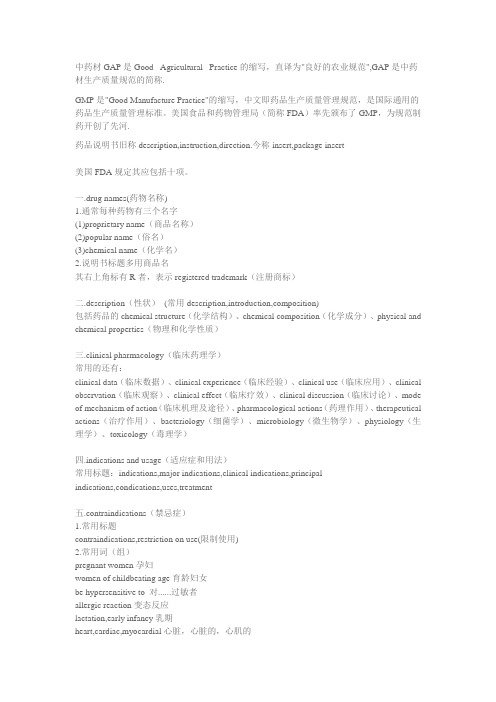
中药材GAP是Good Agricultural Practice的缩写,直译为"良好的农业规范",GAP是中药材生产质量规范的简称.GMP是"Good Manufacture Practice"的缩写,中文即药品生产质量管理规范,是国际通用的药品生产质量管理标准。
美国食品和药物管理局(简称FDA)率先颁布了GMP,为规范制药开创了先河.药品说明书旧称description,instruction,direction.今称insert,package insert美国FDA规定其应包括十项。
一.drug names(药物名称)1.通常每种药物有三个名字(1)proprietary name(商品名称)(2)popular name(俗名)(3)chemical name(化学名)2.说明书标题多用商品名其右上角标有R者,表示registered trademark(注册商标)二.description(性状)(常用description,introduction,composition)包括药品的chemical structure(化学结构)、chemical composition(化学成分)、physical and chemical properties(物理和化学性质)三.clinical pharmacology(临床药理学)常用的还有:clinical data(临床数据)、clinical experience(临床经验)、clinical use(临床应用)、clinical observation(临床观察)、clinical effect(临床疗效)、clinical discussion(临床讨论)、mode of mechanism of action(临床机理及途径)、pharmacological actions(药理作用)、therapeutical actions(治疗作用)、bacteriology(细菌学)、microbiology(微生物学)、physiology(生理学)、toxicology(毒理学)四.indications and usage(适应症和用法)常用标题:indications,major indications,clinical indications,principalindications,condications,uses,treatment五.contraindications(禁忌症)1.常用标题contraindications,restriction on use(限制使用)2.常用词(组)pregnant women孕妇women of childbeating age育龄妇女be hypersensitive to 对......过敏者allergic reaction变态反应lactation,early infancy乳期heart,cardiac,myocardial心脏,心脏的,心肌的kidney,renal肾,肾脏的liver,hepatic肝,肝脏的insufficiency,impairment机能不全damage,danger,failure损伤,危险,衰弱六.precautions(注意事项)常用标题:causions,remark,note,notice,attention,awakening, N.B.七.warnings(警告)常用标题:additional warnings(告戒事项)八.adverse reactions(不良反应)常用标题:side reaction(副反应)、untoward reaction(不良反应)、toxicity reaction(毒性反应)、anaphylactic reaction(过敏反应)、side effects,by-effects,after effects,undesirable effects(副作用)、double infection(双重感染)九.overdosage(用药过量)常用标题:treatment of overdosage(用药过量的治疗)十.dosage and administration(剂量用法)1.常用标题:administration procedure,method for administration,method of use,direction for use,how to use,recommendation,reconstitution(用法)posology,dosage(剂量)application and dosage,usage and dosage(用法与剂量)clinical application(临床应用)2.mode of administration(给药方式)intramuscularly肌肉注射intragluteally臀肌注射intraarterially动脉注射intravenously静脉注射intrathecally鞘内注射intracerebeospinally脑脊髓腔注射orally口服parentarally肠道外给药locally局部给药subconjunctivally结膜下给药sublingually舌下给药submucously黏膜下给药现各大药厂的说明书,项目远远超过十项,如:1.animal pharmacology and animal toxicology(动物药理学和动物毒理学)2.absorption and excretion(吸收和排泄)3.tolerance(耐受性)4.drug interactions(药物相互作用)5.storage and duration of efficacy(贮藏与失效期)6.packages(包装)7.advantages(优点)8.references(参考文献)9.further information(补充说明)10.manufacturer(生产者)英文药品说明书的翻译(1)人吃五谷杂粮没有不生病的。
用药说明书英语翻译
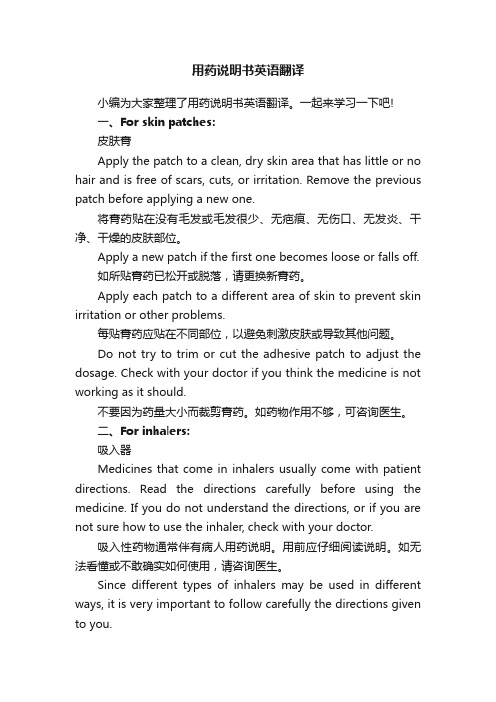
用药说明书英语翻译小编为大家整理了用药说明书英语翻译。
一起来学习一下吧!一、For skin patches:皮肤膏Apply the patch to a clean, dry skin area that has little or no hair and is free of scars, cuts, or irritation. Remove the previous patch before applying a new one.将膏药贴在没有毛发或毛发很少、无疤痕、无伤口、无发炎、干净、干燥的皮肤部位。
Apply a new patch if the first one becomes loose or falls off.如所贴膏药已松开或脱落,请更换新膏药。
Apply each patch to a different area of skin to prevent skin irritation or other problems.每贴膏药应贴在不同部位,以避免刺激皮肤或导致其他问题。
Do not try to trim or cut the adhesive patch to adjust the dosage. Check with your doctor if you think the medicine is not working as it should.不要因为药量大小而裁剪膏药。
如药物作用不够,可咨询医生。
二、For inhalers:吸入器Medicines that come in inhalers usually come with patient directions. Read the directions carefully before using the medicine. If you do not understand the directions, or if you are not sure how to use the inhaler, check with your doctor.吸入性药物通常伴有病人用药说明。
FDA英文药品说明书规定项目中英对照
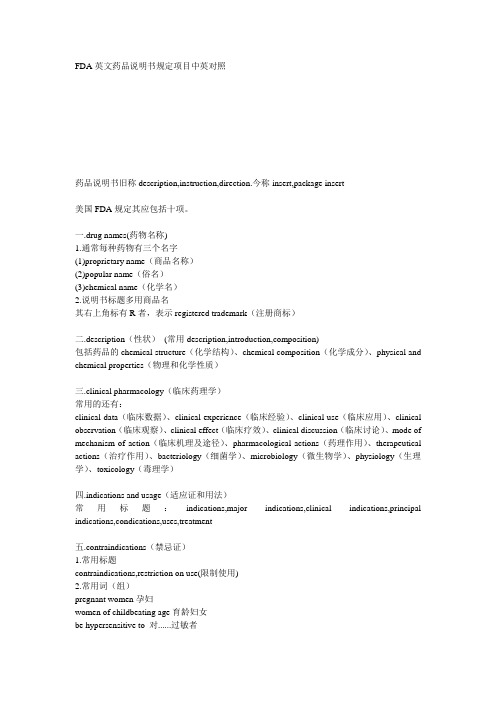
FDA英文药品说明书规定项目中英对照--------------------------------------------------------------------------------药品说明书旧称description,instruction,direction.今称insert,package insert美国FDA规定其应包括十项。
一.drug names(药物名称)1.通常每种药物有三个名字(1)proprietary name(商品名称)(2)popular name(俗名)(3)chemical name(化学名)2.说明书标题多用商品名其右上角标有R者,表示registered trademark(注册商标)二.description(性状)(常用description,introduction,composition)包括药品的chemical structure(化学结构)、chemical composition(化学成分)、physical and chemical properties(物理和化学性质)三.clinical pharmacology(临床药理学)常用的还有:clinical data(临床数据)、clinical experience(临床经验)、clinical use(临床应用)、clinical observation(临床观察)、clinical effect(临床疗效)、clinical discussion(临床讨论)、mode of mechanism of action(临床机理及途径)、pharmacological actions(药理作用)、therapeutical actions(治疗作用)、bacteriology(细菌学)、microbiology(微生物学)、physiology(生理学)、toxicology(毒理学)四.indications and usage(适应证和用法)常用标题:indications,major indications,clinical indications,principal indications,condications,uses,treatment五.contraindications(禁忌证)1.常用标题contraindications,restriction on use(限制使用)2.常用词(组)pregnant women孕妇women of childbeating age育龄妇女be hypersensitive to 对......过敏者allergic reaction变态反应lactation,early infancy乳期heart,cardiac,myocardial心脏,心脏的,心肌的kidney,renal肾,肾脏的liver,hepatic肝,肝脏的insufficiency,impairment机能不全damage,danger,failure损伤,危险,衰?BR>六.precautions(注意事项)常用标题:causions,remark,note,notice,attention,awakening, N.B.七.warnings(警告)常用标题:additional warnings(告戒事项)八.adverse reactions(不良反应)常用标题:side reaction(副反应)、untoward reaction(不良反应)、toxicity reaction(毒性反应)、anaphylactic reaction(过敏反应)、side effects,by-effects,after effects,undesirable effects(副作用)、double infection(双重感染)九.overdosage(用药过量)常用标题:treatment of overdosage(用药过量的治疗)十.dosage and administration(剂量用法)1.常用标题:administration procedure,method for administration,method of use,direction for use,how to use,recommendation,reconstitution(用法)posology,dosage(剂量)application and dosage,usage and dosage(用法与剂量)clinical application(临床应用)2.mode of administration(给药方式)intramuscularly肌肉注射intragluteally臀肌注射intraarterially动脉注射intravenously静脉注射intrathecally鞘内注射intracerebeospinally脑脊髓腔注射orally口服parentarally肠道外给药locally局部给药subconjunctivally结膜下给药sublingually舌下给药submucously黏膜下给药现各大药厂的说明书,项目远远超过十项,如:1.animal pharmacology and animal toxicology(动物药理学和动物毒理学)2.absorption and excretion(吸收和排泄)3.tolerance(耐受性)4.drug interactions(药物相互作用)5.storage and duration of efficacy(贮藏与失效期)6.packages(包装)7.advantages(优点)8.references(参考文献)9.further information(补充说明)10.manufacturer(生产者)。
常用药品监管词汇中英文
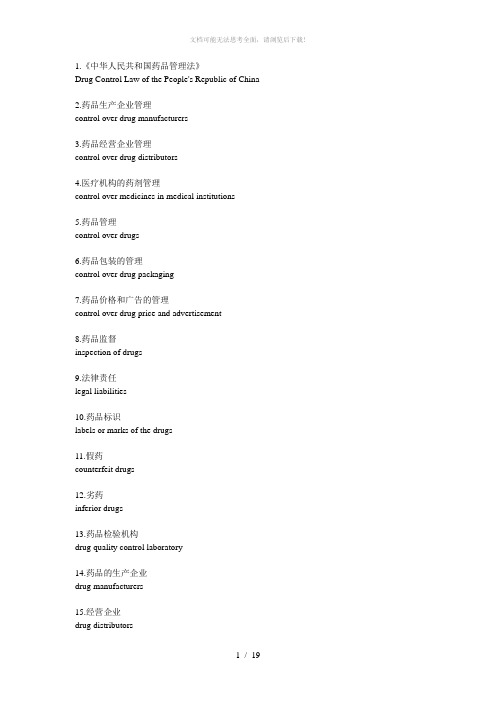
1.《中华人民共和国药品管理法》Drug Control Law of the People's Republic of China2.药品生产企业管理control over drug manufacturers3.药品经营企业管理control over drug distributors4.医疗机构的药剂管理control over medicines in medical institutions5.药品管理control over drugs6.药品包装的管理control over drug packaging7.药品价格和广告的管理control over drug price and advertisement8.药品监督inspection of drugs9.法律责任legal liabilities10.药品标识labels or marks of the drugs11.假药counterfeit drugs12.劣药inferior drugs13.药品检验机构drug quality control laboratory14.药品的生产企业drug manufacturers15.经营企业drug distributors16.医疗机构medical institutions17.药品监督管理部门drug regulatory agency18.药品批准证明文件drug approval documents19.行政处分administrative sanctions20.刑事责任criminal liabilities21.药品生产质量管理规范Good Manufacturing Practice for Pharmaceutical Products (GMP)22.药品经营质量管理规范Good Supply Practice for Pharmaceutical Products (GSP)23.药品生产许可证Drug Manufacturing Certificate24.药品经营许可证Drug Supply Certificate25.医疗机构制剂许可证Pharmaceutical Preparation Certificate for Medical Institution26.进口药品注册证书Import Drug License27.临床试验clinical trial28.新药证书New Drug Certificate29.药品批准文号Drug Approval Number30.在中华人民共和国境内从事药品的研制、生产、经营、使用和监督管理的单位或者个人,必须遵守《中华人民共和国药品管理法》All institutions or individuals engaged in research, production, distribution, use, and administration and supervision of drugs in the People's Republic of China shall abide by drug control law of the people's republic of China.31.国务院药品监督管理部门主管全国药品监督管理工作。
- 1、下载文档前请自行甄别文档内容的完整性,平台不提供额外的编辑、内容补充、找答案等附加服务。
- 2、"仅部分预览"的文档,不可在线预览部分如存在完整性等问题,可反馈申请退款(可完整预览的文档不适用该条件!)。
- 3、如文档侵犯您的权益,请联系客服反馈,我们会尽快为您处理(人工客服工作时间:9:00-18:30)。
Administrative Regulation for Insert and packaging Labels of drug(SFDA Order No.24)State Food and Drug Administration OrderNo.24“Administrative Regulation for Insert and packaging Labels of Drug” had been evaluated & agreed by the management meeting of SFDA by Mar.10, 2006, and publish here, the same to be implemented since June 1st, 2006.SFDA Director: Shao Ming LiMar. 15, 2006 Administrative Regulation for the Insert and Packaging Labels of DrugSection I General rulesNo.1 For standardizing the administration for the insert and packaging labels of drug on the basis of “Drug Administration law of the P. R. of China” and “Regulations for Implementation of the Drug Administration Law of the P. R. of China”.No.2 Relevant inserts and packaging labels for all the drugs which are sold in china to be in line with the requirements from present regulation.No.3 The Inserts and packaging labels of drugs should be approved by SFDA.The packaging labels of drugs to be drafted as per the insert, their text should not exceed the range of insert, and should not contain the character and mark which suggests the efficacy, mislead uses and unsuitable publicity the product.No.4 The label should be printed or stickled on the package for drug as per relevant regulations, and can’t carry any other character, audiovisual, or material for introduction or publication propaganda for product and / or manufacturer.The smallest pack sold in market from the pharmaceutical manufacturer should contain insert.No.5 The text expression for drug’s insert and labels should be scientific, standard and accurate.The text expression for the insert for OTC drug should be easy for understanding for the patients whom could be able to self judges, selects and uses.No.6 The text of drug’s insert and labels should be clear and easy to be differentiated, the mark should be clear and striking, the appearance with dropping words or unstick etc. should not appear, and can't be modified or supplemented by sticking, cutting or altering.No.7 The standard Ch. Character published by State Spoken and Written Language Committee should be used for the insert and labels of drug, the Ch. Character expression will be the criterion when has additional other language for reference.No.8 For the purpose of protecting the public health and guiding the drug to be used by a right and rational way, the pharmaceutical manufacturer may raises forwardly to add the warnings on the drug’s insert or labels, SFDA also may require relevant pharmaceutical manufacturer to add the warnings on the insert or labels.Section II Drug’s insertNo.9 Drug’s insert should contain the important and scientific data, results and information about the safety and efficacy of drug, so that can be able to guide the safe and rational uses of drug.The detail format, contents and written requirement for drug’s insert are drafted and issued by SFDA.No.10 The expression of the disease names, pharmaceutical specialized nouns, drug name, clinical test names and results in the drug’s insert should use the special and standard vocabulary or that one issued by state, and the weights and measures to be in line with the requirements of national standard.No.11 All the APIs or crude drugs in the formula to be listed in the drug’s insert. All the excipients for the injection and OTC drugs are also to be listed in the insert.That’s to be indicated if the formula contains the ingredient(s) or excipient(s) which may cause a serious adverse reaction.No.12 The pharmaceutical manufacturer should track forwardly the safety and efficacy status of drug post market, and should raise the application in time for the modification of drug’s insert if necessary.According to the monitor results for the adverse reactions of drug and the re-evaluation of drug, SFDA also may require the pharmaceutical manufacturer to modify the drug’s insert. No.13 The pharmaceutical manufacturer should inform the modified contents to relevant pharmaceutical business companies, used units and the concerned depts. immediately after the modified insert was approved, and implement the modified insert and labels in time as per the requirements.No.14 Drug’s insert should contain enough information of adverse reactions of drug, and indicate the adverse reactions in detail. If the pharmaceutical manufacturer had not modified the insert in time on the basis of the safety and efficacy status of drug post market or didn’t indicate enough the adverse reactions of drug in the insert, the harmful result caused to be borne by relevant manufacturer.No.15 The approval date and revised date of drug’s insert to be indicated clearly in the insert.Section III Labels of drugNo.16 The labels of drug refer to the contents which are printed or pasted in the package of drug, it divides into internal label or outer label. The internal label refers to that label used for immediate pack, and the outer label refers to that labels used for other packs except internal label.No.17 The internal label of drug should contain the contents of generic name, indications or efficacy, strength, dosage and administration of drug, mfg date, batch No. expiry date, manufacturer etc.If the pack size is too small and can’t be able to cover all the contents above, at least, that contents of generic name of drug, strength, batch No., expiry date etc. should be indicated. No.18 The outer label of drug should indicate the contents of the generic name of drug, ingredient(s), description, indications or efficacy, strength, dosage and administration, adverse reactions, contraindication, warnings & precautions, storage, mfg date, batch No.permission No., manufacturer etc. If the full contents of indications or efficacy, dosage and administration, adverse reactions, contraindication and warnings & precautions can’t be able to be covered, then the major contents to be indicated and note “that details are exhibited in the insert”.No.19 Shipper label should indicate the necessary contents of the generic name of drug, strength, storage, mfg date, batch No., expiry date, permission No., manufacturer etc., also may indicate the package quantity and transport warnings and other mark if necessary.No.20 The label for API should indicate the necessary contents of drug name, storage, mfg date, batch No., expiry date, specification No., permission No., manufacturer etc., and also indicate the pack side and the transport warnings.No.21 For the same drug with same strength and pack size from the same pharmaceutical manufacturer, the text, format and color of the label to be same, for the different strength or pack size, the label should be clearly different or the strength to be indicated clearly.The same drug from the same pharmaceutical manufacturer which is administered for prescription drug as well as OTC drug, the color for both packages should be clearly distinguished respectively.No.22 For the drug which storage has special requirement, the storage to be indicated in a striking place of the label.No.23 The expiry date in the label of drug should be labeled as per the sequence of year-month-date, the year is expressed as 4 numerals, the month and the date is expressed as 2 numerals respectively. The detail format is labeled as expiry by “XXXX year XX month” or “expiry by XXXX year XX month XX date”, also may be labeled as “expiry by XXXX.XX.”or “expiry by XXXX/XX/XX” etc. with the numeral or other symbol.The expiry period for preventative biological products should be labeled as per the SFDA approval specification. For the biological products for treatment, the expiry period to be counted since the repackaging date, but for other drugs, that to be counted since mfg. Date.If the expiry period is labeled up to the date, then the expiry date should be the previous date corresponding the year-month-date against the initial date. If the expiry period is labeled up to the month, then the expiry date should be the previous month corresponding the year-month against the initial date.Section IV Use of drug name and registered trademarkNo.24 The drug name labeled in the insert and labels should be in line with the nominated principle for drug generic name and brand name which is issued by SFDA, and identical with the approval certificate.No.25 The generic name of drug should be notable and outstanding, its font, size and color should be accordant, and in line with the requirements below:(1)For the horizontal label, the generic name of drug should be exhibited within the upperthird area at a marked place.For the standing label, the generic name of drug should be exhibited within the third areaof right at a marked place.(2)The font which is not easy to be identified, i.e. grass hand, seal character can’t beselected, and the font can’t be modified with italic, central emptily, hatching forms etc.(3)The color of font should be black or white, to produce a strong contrast against the tintor dark background.(4)The generic name can’t be written in different rows except the pack size is too small andthe full name can’t be exhibited.No.26 The brand name can’t be set in the same row with the generic name, the font and color of brand name is not more extrusive and distinct than the generic name, the area of single font is not more than the half area of the font of generic name.No.27 The trademark which is not registered and other drug name which is not approved by SFDA are inhibitive to be used for the insert and labels of drug.The registered trademark which is used for drug label should be printed in the side cornerof drug label, if it contains the character, then the area of single font is not more than thequadrant area of the generic name.Section V Other regulationNo.28 For the anaesthetic, psychoactive, medical toxicity drug, radioactive drug and the drug for exterior use and OTC etc. which has special mark issued by state, their inserts and labelsshould print the special mark. The insert and labels which have special requirement will be identified by SFDA.No.29 The administrative regulation for the labels of crude Chinese traditional medicine or dry pieces will be drafted by SFDA by supplementary document.No.30 The insert and labels of drug which didn’t complied with this regulation to be punished as per relevant requirements Drug Administration law of the P. R. of China.Section VI Supplementary articlesNo.31 This regulation will be implemented since June 01, 2006. The SFDA Order No.23 issued by Oct 15, 2000 will be disused synchronously.。
